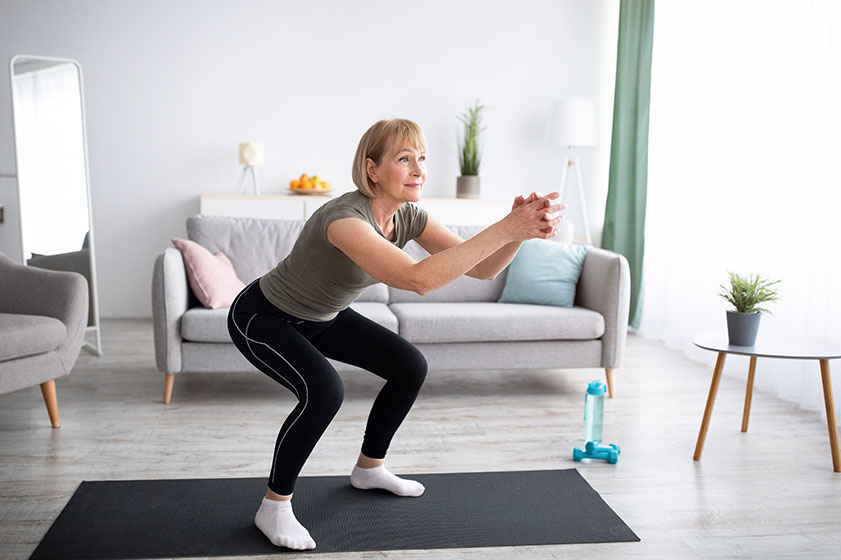Maintaining strength and mobility is essential for a vibrant life. Incorporating effective squat variations for seniors into your routine can help enhance balance, build muscle, and promote overall well-being. We’ll talk about a variety of squats that are not only safe but also effective for improving daily functionality and confidence in movement.
Why Squats Matter
Squats are fundamental exercises that engage multiple muscle groups, particularly in the legs and core. They are important for improving lower body strength and can enhance stability, making everyday tasks easier—like getting in and out of a chair or climbing stairs. Practicing squats regularly can lead to better coordination and reduced risk of falls, which is crucial for maintaining independence.
Getting Started Safely
Before embarking on a new exercise routine, it’s important to ensure your body is prepared. A brief warm-up can help increase blood flow to your muscles, making your workout more effective and enjoyable. Simple movements like marching in place or gentle stretches can prepare you for the exercises ahead.
Squat Variations to Try
- Chair Squats: Chair squats are a fantastic starting point. Stand in front of a sturdy chair, feet shoulder-width apart. Slowly lower yourself as if you’re about to sit, making sure your back is straight and your knees are aligned over your toes. Lightly touch the chair seat without fully sitting down, then press through your heels to stand back up. This variation offers support while helping to build foundational strength.
- Wall Squats: For wall squats, position yourself with your back against a wall, feet about a foot away from it. Slide down until your thighs are parallel to the ground, or as far as is comfortable for you. Hold this position for a few seconds, then slide back up to a standing position. Wall squats not only strengthen the legs but also provide support for your back, making them a great choice for those who may need a little extra assistance.
- Supported Squats: Supported squats can be performed using a countertop or sturdy railing. Stand beside the support and lightly hold on as you squat down. Bend your knees and push your hips back while keeping your chest lifted. This variation allows you to control the depth of the squat while enhancing your balance. It’s a perfect option for anyone looking to gain confidence in their movements.
- Partial Squats: If you’re new to squatting, partial squats are a gentle way to start. Stand with your feet shoulder-width apart and bend your knees slightly, lowering your body just a few inches. Maintain a straight back and look forward. This simple movement focuses on building strength without overexerting yourself. Over time, you can gradually increase the depth of your squats as you become more comfortable.
- Sumo Squats: Sumo squats add a fun twist to your routine. Stand with your feet wider than shoulder-width apart and turn your toes slightly outward. Lower into a squat, pushing your hips back while keeping your knees aligned with your toes. This variation targets inner thigh muscles and helps improve hip flexibility. It’s a great way to add variety to your exercise routine.
- Seated Squats: For seated squats, sit at the edge of a chair with your feet flat on the ground. Lean slightly forward and stand up without using your hands for support. Focus on keeping your back straight and your core engaged. Slowly lower yourself back into the chair with control. This exercise strengthens your legs and improves your ability to transition from sitting to standing, a valuable skill for everyday life.
- Assisted Single-Leg Squats: To perform assisted single-leg squats, hold onto a support with one hand while lifting one foot slightly off the ground. Bend the knee of the standing leg to lower yourself into a squat. This exercise not only builds strength in the legs but also challenges your balance. After a few repetitions, switch to the other leg. This variation helps enhance stability and coordination.
Tips for Successful Squatting
When practicing these squat variations, focus on maintaining proper form to avoid injury. Make sure your knees stay aligned with your toes and your back remains straight throughout each movement. Breathe naturally: inhale as you lower down and exhale as you rise. Start with a few repetitions of each variation and gradually increase as your strength improves. Listening to your body is key; if something doesn’t feel right, don’t hesitate to adjust or take a break.
Making Squats Part of Your Routine
Integrating these exercises into your daily life can lead to significant improvements in strength and mobility. Consider setting aside specific times each day to practice your squats, whether it’s in the morning, during a break, or before bed. Even simple activities like standing up from a chair without assistance can make a positive difference over time.
Integrating these squat variations into your daily routine can lead to significant improvements in strength and mobility, helping you maintain independence and confidence in your movements. Consistent practice, even with small steps, will bring noticeable benefits over time, empowering you to move more comfortably and safely in everyday life.
A retirement community can provide invaluable support in achieving these fitness goals. With access to personalized exercise programs, trained professionals, and dedicated spaces for safe physical activity, residents can engage in tailored fitness routines like these squat variations.
Whether you’re looking for group classes that foster social interaction or one-on-one guidance from fitness specialists, a retirement community can help you stay active, build strength, and improve mobility.







